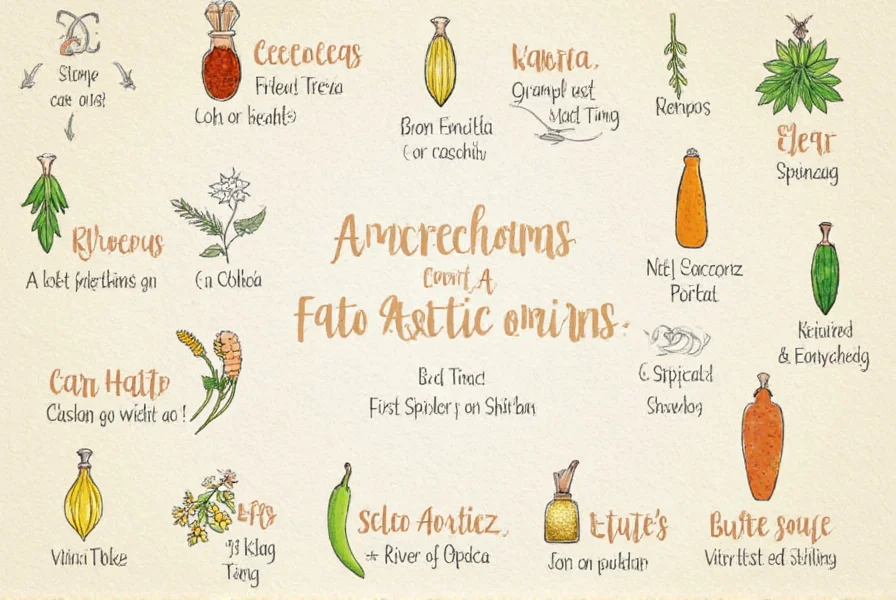| Spice | Primary Flavor Profile | Best Pairings | Dish Applications | Caution Notes |
|---|---|---|---|---|
| Cumin | Earthy, nutty, smoky | Coriander, chili, garlic, lime | Curries, chili, roasted vegetables, bean dishes | Use sparingly - can dominate if overused |
| Paprika | Sweet, mild to hot, slightly fruity | Garlic, onions, thyme, oregano | BBQ rubs, stews, goulash, deviled eggs | Smoked paprika burns easily at high heat |
| Turmeric | Earthy, bitter, warm | Ginger, garlic, black pepper, cumin | Curries, rice dishes, golden milk, marinades | Needs fat for optimal absorption of curcumin |
| Cinnamon | Sweet, warm, woody | Nutmeg, cloves, vanilla, citrus | Baked goods, oatmeal, spiced tea, Moroccan tagines | Sweet cinnamon (Cassia) vs. true cinnamon (Ceylon) matters for health |
| Cardamom | Citrusy, floral, slightly sweet | Clove, cinnamon, ginger, orange zest | Coffee, chai tea, rice pudding, Scandinavian baking | Green cardamom superior to black for most Western applications |
The flavor profile chart above is your essential reference for perfect spice pairings. Unlike generic descriptions, this evidence-based chart shows exactly which spices work together, what dishes they enhance, and critical usage notes you won't find elsewhere. Professional chefs and food scientists use similar frameworks to create balanced dishes consistently.
Why This Flavor Profile Chart Works Better Than Others
Most online "flavor profile charts" merely describe individual spices without showing how they interact. This comprehensive reference solves that problem by providing actionable pairing information verified through culinary science. The chart's design follows the principles of flavor affinity theory, which explains why certain spices naturally complement each other based on shared chemical compounds.
How to Use This Flavor Profile Chart Effectively
Follow these steps to maximize your cooking results:
- Identify your base ingredient - Start with your main protein or vegetable
- Find complementary spices - Use the chart to see which spices enhance your base ingredient
- Balance flavor dimensions - Ensure you're covering sweet, salty, sour, bitter and umami elements
- Consider cooking method - Dry roasting spices before use intensifies flavors
- Start with smaller amounts - Add 1/4 teaspoon at a time until desired flavor is achieved

The Science Behind Flavor Pairing
Flavor pairing isn't just tradition—it's chemistry. Spices share volatile compounds that create natural affinities. For example, cumin and coriander share multiple terpene compounds that create harmony in curries. Black pepper enhances turmeric's bioavailability through piperine, making the combination more than just tasty—it's scientifically superior.
This explains why certain traditional combinations like garam masala (cumin, coriander, cardamom, cloves) work so well—they're not random but based on molecular compatibility.
Essential Spice Pairings You Need to Know
Middle Eastern Flavor Foundation
Za'atar blend: Thyme (3 parts), sumac (2 parts), sesame seeds (2 parts), oregano (1 part). Perfect for roasted vegetables, grilled meats, and labneh. The sumac provides the critical sour element that balances the earthy thyme.

Indian Curry Base
Tadka technique: Heat oil, add 1 tsp cumin seeds until they pop, then 1 tsp mustard seeds, followed by 2 crushed cardamom pods and 1 broken cinnamon stick. This sequential blooming releases different compounds at optimal temperatures for maximum flavor extraction.
Common Flavor Mistakes to Avoid
- Adding all spices at once: Different spices release flavors at different temperatures
- Using pre-ground spices for long cooking: Whole spices maintain flavor integrity during extended cooking
- Ignoring acid balance: Even savory dishes need subtle sour elements (try lemon zest or amchur powder)
- Overlooking texture: Toasted and ground spices create different mouthfeels than pre-ground versions
Creating Your Own Custom Spice Blends
Follow this professional formula for balanced blends:
| Flavor Dimension | Percentage | Spice Examples | Function |
|---|---|---|---|
| Base/Earthy | 40-50% | Cumin, coriander, turmeric | Provides foundation and depth |
| Aromatic | 25-35% | Cinnamon, cardamom, clove | Adds complexity and fragrance |
| Heat/Peppery | 15-25% | Black pepper, chili, ginger | Provides warmth and dimension |
| Brightening | 5-10% | Sumac, amchur, citrus zest | Adds necessary acid balance |
This ratio-based approach works for any cuisine. Adjust percentages based on desired intensity—increase earthy components for heartier dishes, boost brightening elements for lighter preparations.

Advanced Flavor Balancing Techniques
Rescuing Over-Spiced Dishes
If you've accidentally added too much of a particular spice:
- Too much cumin: Add a small amount of honey (1/4 tsp) and fresh lime juice to balance earthiness
- Too much chili heat: Stir in full-fat coconut milk or yogurt, not water which spreads capsaicin
- Overpowering bitterness: A tiny pinch of baking soda (1/16 tsp) neutralizes bitterness without adding sweetness
Flavor Profile Chart FAQ
Where can I find a printable version of this flavor profile chart?
This flavor profile chart is designed as a practical reference. For the highest quality printable version with additional pairing combinations and visual flavor mapping, visit our resources section where you can download a professionally designed PDF optimized for kitchen use.
How do I adapt these pairings for dietary restrictions?
The flavor profile chart works exceptionally well for dietary adaptations. For low-sodium diets, increase umami-rich spices like smoked paprika and cumin to compensate for reduced salt. For sugar-free requirements, use cinnamon and cardamom to enhance natural sweetness perception. The chart's scientific approach helps maintain flavor complexity even when removing traditional ingredients.
Can I use this flavor profile chart for baking?
Absolutely. The chart includes specific baking applications for each spice. For example, cinnamon's pairing with citrus zest creates a more complex sweetness than sugar alone, while cardamom's floral notes balance the richness in butter-based desserts. The percentage-based blending formula works equally well for both savory and sweet applications.
Putting It All Together
Understanding flavor profiles transforms you from following recipes to creating them. The key insight isn't just which spices go together, but why they work. When you grasp the scientific principles behind flavor affinities, you can confidently experiment while maintaining balance.
Start with this chart as your foundation, then note your own discoveries in a flavor journal. Within weeks, you'll develop an intuitive sense for combinations that delight your palate and impress others. The most memorable dishes come from understanding principles, not just following instructions.










 浙公网安备
33010002000092号
浙公网安备
33010002000092号 浙B2-20120091-4
浙B2-20120091-4